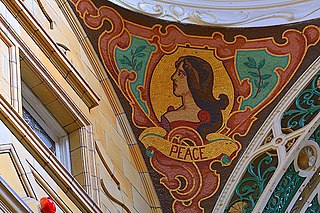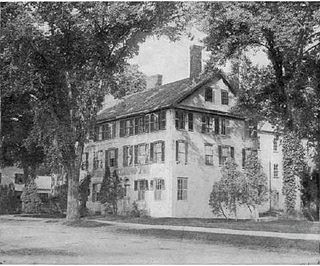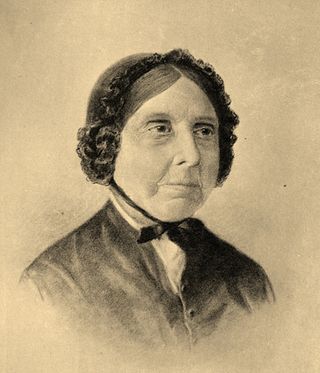
Burmantofts Pottery was the common trading name of a manufacturer of ceramic pipes and construction materials, named after the Burmantofts district of Leeds, England.

The history of Dedham, Massachusetts, from 1800 to 1899 saw growth and change come to the town. In fact, the town changed as much during the first few decades of the 19th century as it did in all of its previous history.

FHR Fred Robertson Los Angeles Pottery was a small studio art pottery manufacturer in Los Angeles, California, from approximately 1906 to approximately 1921.

Art pottery is a term for pottery with artistic aspirations, made in relatively small quantities, mostly between about 1870 and 1930. Typically, sets of the usual tableware items are excluded from the term; instead the objects produced are mostly decorative vessels such as vases, jugs, bowls and the like which are sold singly. The term originated in the later 19th century, and is usually used only for pottery produced from that period onwards. It tends to be used for ceramics produced in factory conditions, but in relatively small quantities, using skilled workers, with at the least close supervision by a designer or some sort of artistic director. Studio pottery is a step up, supposed to be produced in even smaller quantities, with the hands-on participation of an artist-potter, who often performs all or most of the production stages. But the use of both terms can be elastic. Ceramic art is often a much wider term, covering all pottery that comes within the scope of art history, but "ceramic artist" is often used for hands-on artist potters in studio pottery.

Augustus Bradford Endicott was a Massachusetts state legislator and sheriff of Norfolk County.

Hugh C. Robertson (1845–1908) was the first American studio potter who experimented with new ceramic glazes. Born in England, Robertson apprenticed at the Jersey City Potter in 1860. In 1868, he started work in his father's shop that had opened in 1866 in Chelsea, Massachusetts. In 1872 the factory was incorporated into the Chelsea Keramic Art Works (CKAW). The company became known for their antique Grecian terra cotta and Pompeian bronzes. In 1877, Robertson developed the Chelsea faience, underglazed opaque earthenware, which led the development of other American faience. There in 1884, Robertson worked on discovering the famous Chinese sang de boeuf glaze. In 1888, he finally discovered the recipe for the glaze and produced three hundred pieces of what he dubbed, Sang de Chelsea.

Charles Fergus Binns was an English-born studio potter. Binns was the first director of the New York State School of Clayworking and Ceramics, currently called the New York State College of Ceramics at Alfred University. He began his position in 1900 and retired in 1931. His work included authorship of several books on the history and practice of pottery. Some of his more notable students included Arthur Eugene Baggs, William Victor Bragdon, R. Guy Cowan, Maija Grotell, Elizabeth Overbeck, and Adelaide Alsop Robineau. This has led Binns to be called "the father of American studio ceramics".

The Dedham Community House is a house on the banks of the Charles River in Dedham, Massachusetts, owned and operated by the Dedham Community Association.

The Dedham Museum and Archive, is a historical society dedicated to preserving and establishing a greater sense of appreciation for the history of Dedham, Massachusetts. It consists of a museum and an archive. As of 2002, it had nearly 1,000 members.
The history of St. Mary's Church in Dedham, Massachusetts begins with the first mass said in Dedham, Massachusetts in 1843 and runs to the present day.

American art pottery refers to aesthetically distinctive hand-made ceramics in earthenware and stoneware from the period 1870-1950s. Ranging from tall vases to tiles, the work features original designs, simplified shapes, and experimental glazes and painting techniques. Stylistically, most of this work is affiliated with the modernizing Arts and Crafts (1880-1910), Art Nouveau (1890–1910), or Art Deco (1920s) movements, and also European art pottery.

The Norfolk House also known as the Norfolk Hotel, was a tavern in Dedham, Massachusetts originally built in 1801 and located at 19 Court Street. It hosted John Quincy Adams, Andrew Jackson, and the Marquis de Lafayette.

Sang de boeuf glaze, or sang-de-boeuf, is a deep red colour of ceramic glaze, first appearing in Chinese porcelain at the start of the 18th century. The name is French, meaning "ox blood", and the glaze and the colour sang de boeuf are also called ox-blood or oxblood in English, in this and other contexts.
Nathaniel Ames represented Dedham, Massachusetts in the Great and General Court.
Patrick O'Beirne was an Irish-born priest who ministered in the Archdiocese of Boston.
The Daniel Slattery house was the site of the first Catholic mass in Dedham, Massachusetts.

St. Mary's School and Asylum was a Catholic girls' school and orphanage in Dedham, Massachusetts.

The history of Dedham, Massachusetts in the 20th century saw great growth come to the town. It played host to the Sacco and Vanzetti trial, saw the Endicott Estate and a number of schools constructed, a great deal of economic development, and growth in the number of services provided by the Town.

This is a timeline of the history of the town of Dedham, Massachusetts.

Hannah Shuttleworth (1800-1886) was a philanthropist from Dedham, Massachusetts.




















